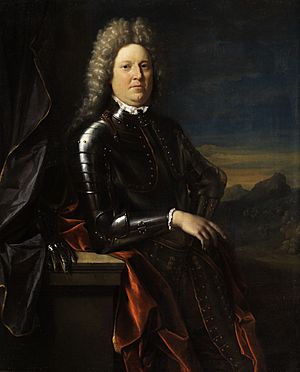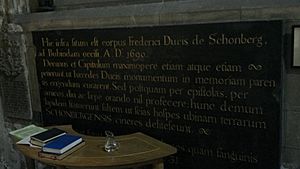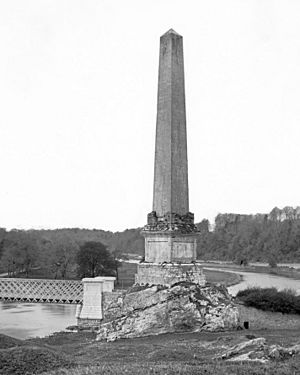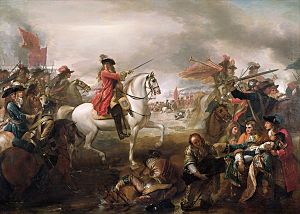Frederick Schomberg, 1st Duke of Schomberg facts for kids
Quick facts for kids
The Duke of Schomberg
|
|
|---|---|
 |
|
| Master-General of the Ordnance | |
| In office 1689–1690 |
|
| Monarch | William III |
| Preceded by | Lord Dartmouth |
| Succeeded by | Earl of Romney |
| Personal details | |
| Born |
Friedrich Hermann von Schönberg
6 December 1615 Heidelberg, Palatinate |
| Died | 16 October 1693 (aged 77) Turin, Savoy |
| Spouse | Johanna Elizabeth (m. 1638) |
| Children | 6, including Charles and Meinhardt |
| Parents | Hans Meinhard von Schönberg Anne Sutton |
Frederick Herman de Schomberg (born December 6, 1615 – died October 16, 1693) was a famous military leader. He was born in Germany. He served as the Master-General of the Ordnance in England from 1689 to 1690. This job meant he was in charge of all weapons and military supplies.
Schomberg fought in many armies during his life. These included the French, Portuguese, and English armies. He was killed in battle in 1690. This happened during the Battle of the Boyne in Ireland.
Contents
Early Life and Military Career
Frederick Herman de Schomberg was born in Heidelberg, Germany. His family was old and well-known. His father was Count Hans Meinhard von Schönberg. His mother was Anne Sutton. Sadly, he became an orphan just a few months after he was born.
Different family friends helped raise and educate him. One of them was Frederick V, Elector Palatine. Schomberg started his military journey with Frederick Henry, Prince of Orange. In 1634, he joined the Swedish army. Then, in 1635, he began serving France.
Serving in Different Armies
After some time, Schomberg went back to his family home. But in 1639, he joined the Dutch army again. He stayed there until about 1650. Then, he went back to the French army as a general. He fought under a famous general named Turenne. Schomberg quickly became a lieutenant-general in 1665.
After a peace treaty in 1659, Spain threatened Portugal's freedom. Schomberg was sent to Portugal to help. He was a military adviser. He took command of an English group of soldiers. This group had about 3,000 men. Many of them were experienced soldiers from the English Civil War.
Schomberg and the Portuguese commander won an important battle. It was called the Battle of Montes Claros in 1665. This victory helped Portugal gain its independence from Spain.
Return to France and Later Service
After the war, Schomberg went back to France. He became a French citizen. The King of Portugal rewarded him for his help. He received a special title and a yearly payment.
In 1673, King Charles II of England asked Schomberg to come to England. He was to lead a new army. This army was meant to fight the Dutch. But a peace treaty was signed, and the army was not used.
Schomberg then served France again. He fought in Spain. He won back a fort called Bellegarde in 1675. Because of this, he was made a Marshal of France. This is a very high military rank.
Leaving France
Schomberg was a Protestant. At this time, Protestants in France were facing difficulties. The King of France took away the Edict of Nantes in 1685. This law had protected Protestants. Because of this, Schomberg had to leave France.
He then became the chief general for the Frederick William, Elector of Brandenburg. In Berlin, he became a leader for many other Protestant refugees. Soon after, he joined Prince William of Orange. William was planning an expedition to England in 1688. This event is known as the Glorious Revolution. Schomberg was William's second-in-command.
The next year, Schomberg received high honors in England. He became a Knight of the Garter. He was also made Master-General of the Ordnance. He was given the title Duke of Schomberg. The English Parliament also gave him a large sum of money. This was to make up for the French lands he had lost.
Fighting in Ireland
In July 1689, King William appointed Schomberg as the commander-in-chief. He was to lead an expedition to Ireland. The goal was to remove James II from Ireland. Schomberg left for Ireland on July 20, 1689.
He landed in Ballyholme Bay on August 13, 1689. He marched his troops to Carrickfergus. This town was held by James II's supporters. Schomberg began the siege on August 20. The town surrendered on August 28.
Schomberg then marched to Dundalk. His army was new and not well-trained. It was also smaller than the enemy's army. So, he decided not to risk a big battle. He built defenses at Dundalk. Soon after, many of his soldiers got sick. When they moved to winter camps, his army was very weak.
Some people criticized his actions. But his caution was necessary. He even offered his own money to King William for military use. This showed his generous spirit.
In the spring, he captured Charlemont. But the army did not move further south until King William arrived with more soldiers.
Death at the Battle of the Boyne
At the Battle of the Boyne on July 1, 1690, Schomberg disagreed with William. William wanted to cross the river even though the enemy was waiting. Schomberg thought it was too risky.
During the battle, Schomberg rode into the river to encourage his men. He was wounded twice in the head. Then, he was shot in the neck and died instantly.
Family Life
Frederick Schomberg had several children. His oldest son was Charles Schomberg. Charles became the second Duke after his father's death. Sadly, Charles died in 1693 from wounds he received in battle. Schomberg's other son was Meinhardt Schomberg, 3rd Duke of Schomberg.
Burial and Memorials

Schomberg was buried in St Patrick's Cathedral, Dublin, Ireland. A monument was built there in his memory in 1731. The monument has a Latin inscription written by Jonathan Swift.
The English translation of the inscription says: Here below is placed the body of Frederick, Duke of Schomberg, killed at the Boyne, A.D. 1690. The dean and the chapter fervently sought, again and again, that the heirs of the Duke see to the erection of a monument in memory of (their) parent. But, after asking for a long time and often, through letters, through friends, they accomplished nothing; finally they set up this stone; so that at least, visitor, you might know where in the world the ashes of Schomberg are concealed. The fame of his valor had more influence among strangers than the relationships of blood did among his own (family). A.D. 1731

There was also a tall stone monument called the Boyne Obelisk. It was built in 1736 to remember the Battle of the Boyne. It had an inscription about Schomberg. It said: Marshal the Duke of Schomberg in passing this river died bravely fighting in defence of liberty
This monument was later destroyed in 1923. The village of Schomberg, Ontario in Canada is named after him.
See also
 In Spanish: Federico de Schomberg para niños
In Spanish: Federico de Schomberg para niños


